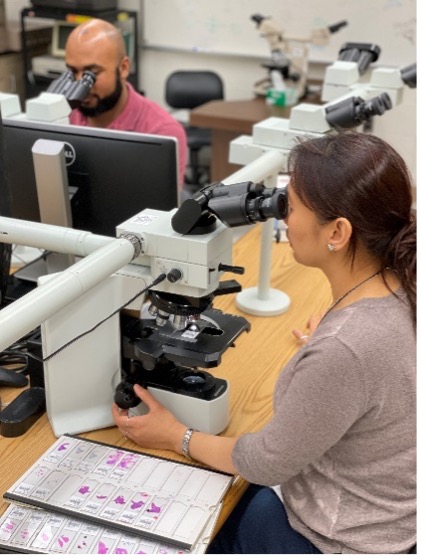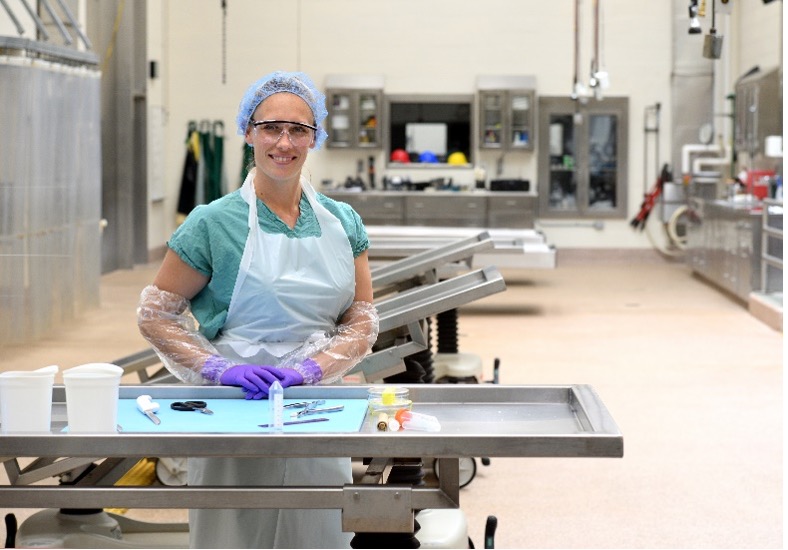Michigan State University
Program

MSU in its collaboration with the NIH CBSTP provides foundational diagnostic pathology training at the university, prior to the trainees’ dissertation research, which is carried out at the NIH. The Department of Pathobiology and Diagnostic investigation (PDI) in the College of Veterinary Medicine at Michigan State University fosters excellence in research, teaching, service, and outreach. The department strives to provide an excellent environment for trainees, veterinary and graduate students, faculty and staff. The specific objectives of the department are to: furnish a high quality and technologically advanced experience in both pre-clinical and clinical years for the Doctor of Veterinary Medicine Degree Program; support innovative graduate degree programs leading to the Doctor of Philosophy Degree in pathology; generate and disseminate new knowledge in pathology; and distribute novel and pathologically relevant information through scholarly publications, research proposals, and collaborative research efforts.
Facilities
The MSU VDL is one of the premier veterinary diagnostic laboratories in the world and provides full-service laboratory support using state-of-the-art facilities and equipment to the MSU Veterinary Medical Center, as well as to clients nationally and internationally. VDL service sections include: Anatomic & Surgical Pathology, Clinical Pathology, Bacteriology & Mycology, Endocrinology, Immunodiagnostics & Parasitology, Nutrition, Toxicology, and Virology. The VDL anatomic pathology section provides surgical and molecular pathology and necropsy services for all species. The section incorporates specialized testing and services including: oncopathology, dermatopathology, ocular pathology, and hepatic and gastrointestinal specialties, melanoma and mast cell tumor diagnostics and prognostication, lymphoma clonality testing, automated immunohistochemistry and in situ hybridization, and genetic testing.
The necropsy service has large, well-equipped BL2 and BL3 necropsy suites, designated rooms for avian necropsies, demonstration viewing areas, and advanced equipment for telecommunication and digital gross imaging. Other capabilities include performance of GLP studies, laser capture microdissection, generation of tissue-microarrays, and electron microscopy. The VDL is devoted to staying on the cutting edge of diagnostics and recent investments have included movement to a ‘green’ (xylene free) histology department with automated slide staining and cover slipping, digital PCR, and next generation sequencing.


Curriculum/Degree Requirements
Residents in the NIH CBSTP combined residency and PhD program at MSU will be located at the VDL and participate in both the necropsy and surgical biopsy services. Residents will enroll in the MSU Comparative Medicine and Integrative Biology Program (CMIB) as a graduate student. The major goal of our graduate training program is to select and train scientists, with or without clinical training, to design and conduct hypothesis-driven studies that elucidate the cellular and molecular mechanisms of diseases. Our program is committed to providing excellent graduate training in comparative pathology and resident training in diagnostic veterinary anatomic and clinical pathology.
VDL Case Load
|
Percentage of case submissions by species |
||||
|
Small Animals |
Large Animals |
Exotic/Zoo Animals |
Lab Animals |
|
|
Biopsy |
95 % |
3 % |
1 % |
1 % |
|
Necropsy |
55 % |
35 % |
5 % |
5 % |
The anatomic pathology section receives ~1200 necropsy cases and ~17000 biopsy cases annually.
Specialty Rounds
Dermatopathology, Oncology/Integrated Pathology, Ocular Pathology, Clinical Pathology, Gross Image, Necropsy, Laboratory Animal
Required Course Work
Courses:
24 credits
Dissertation research:
24 credits
Required Courses:
|
COURSE |
CREDITS/WORKSHOPS |
|
Advanced General Pathology |
3 credits |
|
Advanced Systemic Pathology |
3 credits |
|
Advanced Clinical Pathology |
3 credits |
|
Case Based Seminar |
2 credits |
|
Selective courses in Pathology, Biochemistry, Molecular Biology or Cell Biology |
6 credits |
|
Selective courses in Statistics, Experimental Design, Epidemiology |
3 credits |
|
Responsible Conduct of Research seminar series |
7 workshops |
Elective Pathology courses that may be used to fulfill the total course requirements:
|
Courses |
Credits |
|
Laboratory Animal Pathology |
2 credits |
|
Pathology of Neoplastic Diseases of Domestic Animals |
2 credits |
|
Avian Pathology |
2 credits |
Time Spent in Activities For Combined Pathology/PhD Training
|
ANATOMIC PATHOLOGY |
SERVICE |
TEACHING |
SEMINAR/COURSES |
RESEARCH |
OTHER |
|
Year 1 Combined Program |
50-60 |
15 |
25 |
5 |
5-10 |
|
Year 2 Combined Program |
50-60 |
15 |
25 |
5 |
5-10 |
|
NIH Dissertation Research |
0 |
0 |
10 |
90 |
|
Trainees will regularly rotate through necropsy and surgical biopsies, and be exposed to clinical pathology via courses, rounds and seminars. While on service, residents will be under the supervision of a senior pathologist.
Teaching
Trainees will assist with instruction of veterinary students in the pathology clerkship through necropsy service duty and classroom instruction. There are also select teaching opportunities in the preclinical curriculum. Many residents are also involved in leading rounds sessions with the MSU CVM Pathology Club.
Travel and Attendance of meetings and Workshops
Residents receive yearly travel funds and dedicated time off service that allow them to attend national training sessions including C.L. Davis courses and symposia. All residents annually attend and present cases at the Midwest Association of Veterinary Pathologists (MAVP) annual meeting. Most residents annually attend and present at the ACVP or AAVLD national meetings.


MSU surgical pathology rounds room (left) and MSU VDL BL2 necropsy floor (right).
Staff
- Dalen Agnew Link DVM, PhD, DACVP,Department Chair, Professor Interest: Comparative Reproductive and Zoo and Wildlife Pathology, Conservation Biology
- Tuddow Thaiwong Link DVM, PhD, DACVP, Academic Specialist Interest: Cancer Biology, Genetics, Applied Molecular Biology in Diagnostics
- Erica Noland Link DVM, MS, DACVP, Assistant Professor Interests: Surgical Pathology, Dermatopathology
- Dodd Sledge Link DVM, PhD, DACVP, Academic Specialist, Section Chief of Anatomic Pathology Interest: Ocular pathology, Pathology of Production, Animals, Neoplasia
- Sarah Corner Link DVM, PhD, DACVP, Academic Specialist, Anatomic Pathology Residency Coordinator Interest: Surgical Pathology, Neoplasia, Molecular Pathology, Reproductive Pathology, Zoo & Wildlife Pathology
- Stephanie French Link DVM, MS, DACVP, Academic Specialist Interest: Surgical Pathology, Necropsy, Reproductive Pathology, Zoo & Wildlife Pathology, Dermatopathology
- Mayra Tsoi Link DMV, PhD, DACVP, Assistant Professor Interest: Pathology of the Respiratory and Reproductive Systems, Avian Pathology, Oncopathology
- Victoria Watson Link DVM, PhD, DACVP, Assistant Professor Interest: Gastrointestinal Disease, Hepatopathology, Zoo/Exotic Pathology, Comparative Pathology
- Scott Fitzgerald Link DVM, PhD, DACVP, Professor Interest: Comparative Pathology of the Urinary Tract and Avian and Wildlife Species
- Richard Fulton Link DVM, PhD, Professor Interests: Pathology of Avian Diseases
- Jack Harkema Link Jack Harkema LinkDVM, PhD, DACVP, University Distinguished Professor Interest: Respiratory Pathology and Inhalation Toxicology
- Matti Kiupel Link Dr. vet. med. habil, PhD, DACVP, Professor Interest: Diagnostic Molecular Pathology (IHC, in-situ, LCM), Tumor Pathology and Ferret Diseases
- Rebecca Smedley Link DVM, MS, DACVP, Senior Academic Specialist, Biopsy Coordinator Interest: Tumor pathology, Pathology of Bone, Hepatopathology
- Cynthia Lucidi Link DVM, PhD, DACVP Assistant Professor, Clinical Pathology, Clinical Pathology Residency Coordinator Interest: Immune-mediated cytopenias, Blood and Bone marrow disorders, Flow cytometry
- Julia Stickle Link DVM, PhD, DACVP, Associate Professor, Clinical Pathology Interests: Diagnostic Clinical Pathology, Research in Pedagogy in Veterinary Medical Education
- Cheryl Swenson Link DVM, PhD, DACVP, Associate Professor, Clinical Pathology Feline Leukemia Virus and Anti-Retroviral Research
- Jennifer Thomas Link DVM, PhD, DACVP, Associate Professor, Section Chief Clinical pathology Hemostasis and Spontaneous Hemostatic Disorders
Links
Disclaimer: This information is provided as general background only, is not specific program policy and is subject to change. Since graduate education is highly individualized you are advised to check with the university program directly for up to date information and requirements.

